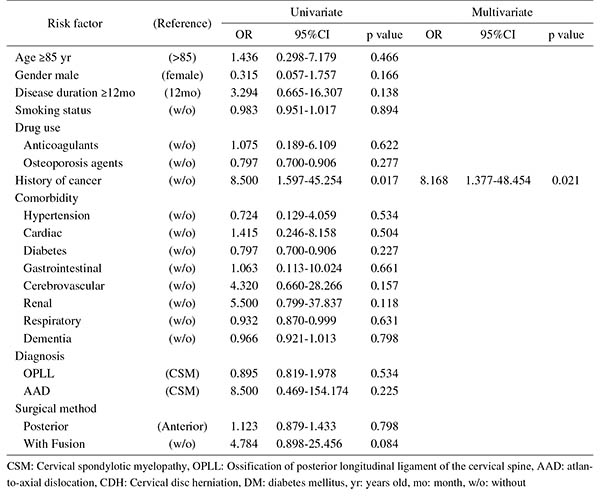- 著者
- Noritaka Hamano Hitoshi Shitara Tsuyoshi Tajika Tsuyoshi Ichinose Tsuyoshi Sasaki Takuro Kuboi Daisuke Shimoyama Masataka Kamiyama Ryosuke Miyamoto Fumitaka Endo Kurumi Nakase Tsutomu Kobayashi Atsushi Yamamoto Kenji Takagishi Hirotaka Chikuda
- 出版者
- The Japanese Association of Rehabilitation Medicine
- 雑誌
- Progress in Rehabilitation Medicine (ISSN:24321354)
- 巻号頁・発行日
- vol.6, pp.20210015, 2021 (Released:2021-03-10)
- 参考文献数
- 32
Objectives: We aimed to examine the relationship between the hip range of motion (ROM) and ankle ROM and throwing-related shoulder and elbow injuries in elementary school baseball pitchers.Methods: This retrospective comparative study (Level of evidence: Level III) included 195 baseball pitchers (mean age 10.8±1.0 years, range 8–12 years). All pitchers underwent physical function measurements, including height, weight, shoulder strength, and hip and ankle ROM. Shoulder and elbow injury was defined as shoulder and elbow pain that the pitchers had been aware of in the past or at the time of medical checkups. The results for the injured and non-injured groups were then compared.Results: The shoulder ROM and strength in the injured and non-injured groups did not differ to a statistically significant extent. The hip external rotation on the dominant side (injured vs. non-injured: 48.9±11.1° vs. 53.3±9.7°, P<0.01), the hip internal rotation on the non-dominant side (injured vs. non-injured: 36.6±12.0° vs. 40.9±11.0°, P=0.01), and ankle plantar flexion on the non-dominant side (injured vs. non-injured: 52.0±6.8° vs. 54.3±6.7°, P=0.02) were significantly smaller in the injured group than in the non-injured group.Conclusions: The hip external rotation ROM on the dominant side and the hip internal rotation and ankle plantar flexion on the non-dominant side were significantly lower in the injured group than in the non-injured group. These results may suggest measures to reduce the incidence of elbow and shoulder injuries in elementary school baseball pitchers.
- 著者
- Koji Tamai Hidetomi Terai Akinobu Suzuki Hiroaki Nakamura Masaomi Yamashita Yawara Eguchi Shiro Imagama Kei Ando Kazuyoshi Kobayashi Morio Matsumoto Ken Ishii Tomohiro Hikata Shoji Seki Masaaki Aramomi Tetsuhiro Ishikawa Atsushi Kimura Hirokazu Inoue Gen Inoue Masayuki Miyagi Wataru Saito Kei Yamada Michio Hongo Kenji Endo Hidekazu Suzuki Atsushi Nakano Kazuyuki Watanabe Junichi Ohya Hirotaka Chikuda Yasuchika Aoki Masayuki Shimizu Toshimasa Futatsugi Keijiro Mukaiyama Masaichi Hasegawa Katsuhito Kiyasu Haku Iizuka Kotaro Nishida Kenichiro Kakutani Hideaki Nakajima Hideki Murakami Satoru Demura Satoshi Kato Katsuhito Yoshioka Takashi Namikawa Kei Watanabe Kazuyoshi Nakanishi Yukihiro Nakagawa Mitsunori Yoshimoto Hiroyasu Fujiwara Norihiro Nishida Masataka Sakane Masashi Yamazaki Takashi Kaito Takeo Furuya Sumihisa Orita Seiji Ohtori
- 出版者
- The Japanese Society for Spine Surgery and Related Research
- 雑誌
- Spine Surgery and Related Research (ISSN:2432261X)
- 巻号頁・発行日
- vol.1, no.4, pp.179-184, 2017-10-20 (Released:2017-11-27)
- 参考文献数
- 26
- 被引用文献数
- 3 3
Introduction: With an aging population, the proportion of patients aged ≥80 years requiring cervical surgery is increasing. Surgeons are concerned with the high incidence of complications in this population, because "age" itself has been reported as a strong risk factor for complications. However, it is still unknown which factors represent higher risk among these elderly patients. Therefore, this study was conducted to identify the risk factors related to surgical complications specific to elderly patients by analyzing the registry data of patients aged ≥80 years who underwent cervical surgery.Methods: We retrospectively studied multicenter collected registry data using multivariate analysis. Sixty-six patients aged ≥80 years who underwent cervical surgery and were followed up for more than one year were included in this study. Preoperative patient demographic data, including comorbidities and postoperative complications, were collected from multicenter registry data. Complications were considered as major if they required invasive intervention, caused prolonged morbidity, or resulted in prolongation of hospital stay. Logistic regression analysis was performed to analyze the risk factors for complications. A p-value of <0.05 was considered as statistically significant.Results: The total number of patients with complications was 21 (31.8%), with seven major (10.6%) and 14 minor (21.2%) complications. Multivariate logistic regression analysis, after adjusting for age, revealed two significant risk factors: preoperative cerebrovascular disorders (OR, 6.337; p=0.043) for overall complications and cancer history (OR, 8.168; p=0.021) for major complications. Age, presence of diabetes mellitus, and diagnosis were not significant predictive factors for complications in this study.Conclusions: Preoperative cerebrovascular disorders and cancer history were risk factors for complications after cervical surgery in patients over 80 years old. Surgeons should pay attention to these specific risk factors before performing cervical surgery in elderly patients.
